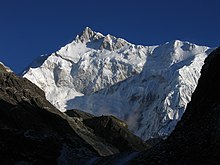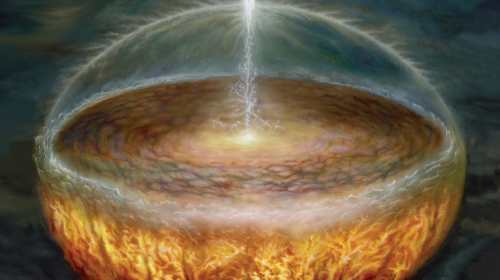:fill(FFCC00,1)/GettyImages-464427161-56a0c55e5f9b58eba4b3ad98.jpg) |
| Nagarjuna Conqueror of the Serpent, 1925. A painting by Nicholas Roerich, (1874-1947) |
The Two Truths doctrine is shared by all the Mahayana schools, though they differ on certain points, in some cases greatly in other less. Nagarjuna, the 2nd-3rd century monk whose philosophy serves as the basis for the Madhyamaka school of Mahayana (and who I have also written about previously in this blog here and here) held that conventional truth, or how reality appears to us, is about cause and effect, and ultimate truth, or about how reality is, is about emptiness, i.e. that reality, including cause and effect, holds no abiding substance from its own side. Some schools whose line of argument does not descend from the Madhyamaka, for example the Yogachara/Cittamatras, hold that there is no external reality at all, not even conventionally, and everything we experience as conventional reality is simply a construct of our minds. Nagarjuna never goes that far, but he doesn't specify any view with respect to ultimate reality, he simply uses negation to refute any view you, or in the case of his best known work Mulamadhyamikakarika (the Karikas for short) a theatrically postulated opponent, happen to raise. To do otherwise would simply raise his opinion to the status of a "view" which one could then subject to negation to refute.
Most of the argument in Mahayana and Vajrayana philosophy is about ultimate truth, but Wright and the discussion that is up right now in Western society, particularly the US, isn't about ultimate truth, at least not directly. It's about relative truth. Specifically, what constitutes relative truth. And there Nagarjuna and the Madhyamaka, regardless of their particular take on ultimate reality, have a clear message: truth is what corresponds to cause and effect. In the context of the generation of human suffering, that's Dependent Arising, or Pratītyasamutpāda in Sanskirt. In the context of everyday life or science, its about a particular collection of causes (some of which are technically known as "conditions" if they are not perceived to be the main cause) leading to an effect [1]. Even if cause and effect and Dependent Arising are not ultimate truth, as Nagarjuna so skillfully argues in the Karikas, they are how we perceive reality. If a postulated collection of causes does not lead to a specified effect, then the statement that there is a causal relationship is not true.
I made the connection with meaning after recently finishing Asanga's (channeling Maitreya's) work Middle Beyond Extremes (Madhyantavibhaga in Sanskirt). I've been struggling with this work for some time now, but after taking a break, I finally managed to put some of it together. What particularly caught my eye is this:
Connection and familiarity,
Lack of connection and no familiarity:
Due to the first two, meaning is present and to the latter two, it is not-
This is being unmistaken about syllables [V.14][2]
What this text is saying is that meaning derives simply from two things: familiarity with the words that were spoken or written and a connection with what the words are designating. The commentaries (in particular, the one written by Ju Mipham, the great 19th century proponent of the Shentong) explain this in more detail. If you are not familiar with the words, for example they are in a language you do not speak or you have never encountered them before, then you won't be able to understand what the other person is saying. Similarly, if you are not familiar with what the words designate, you will not understand. The words will convey no meaning to you. So meaning is really the effect of these two causes, namely familiarity and connection, and their role in human conceptual thought.
The connection between truth and meaning is the following. Meaning is something that is linguistically constructed and is part of the conceptual mind. (Relative) Truth is about cause and effect, a statement about the world. To the extent to which statements about cause and effect are always filtered through the conceptual mind, a disconnect can happen between the truth of how we perceive the world and how we describe it to ourselves (which in many cases can influence how we perceive the world). One person can maintain that the connection sits with a particular designation while the other can maintain that it happens through another designation. Either person can have other reasons for maintaining their view on the designation.
And here's the connection with ultimate truth: because there is no abiding essence to reality, in other words because of emptiness, two people can differ on how they perceive it, on how they perceive the cause and effect. They might even perceive the cause and effect quite differently. The decision to agree about a particular case will therefore cause people to perceive reality differently. That perception can either correspond to the underlying physical realty or it can deny it. To the extent that it denies, the people involved are in for trouble down the road.
Image source: Found in the collection of the International Centre of the Roerichs, Moscow. Photo by Fine Art Images / Heritage Images / Getty Images
[1] I would add here "probabilistically lead to an effect". The ultimate truth of emptiness means that even low probability events, like the sun suddenly disappearing, are still possible. They just don't happen very often if at all. Less extreme cases of multiple possible causes leading probabilistically to an effect are also easy to find. Most classical Buddhist philosophy doesn't deal with probability at all.
[2] Dharmachakra Translation Committee translation, p. 136, Wisdom Books, 2006.






